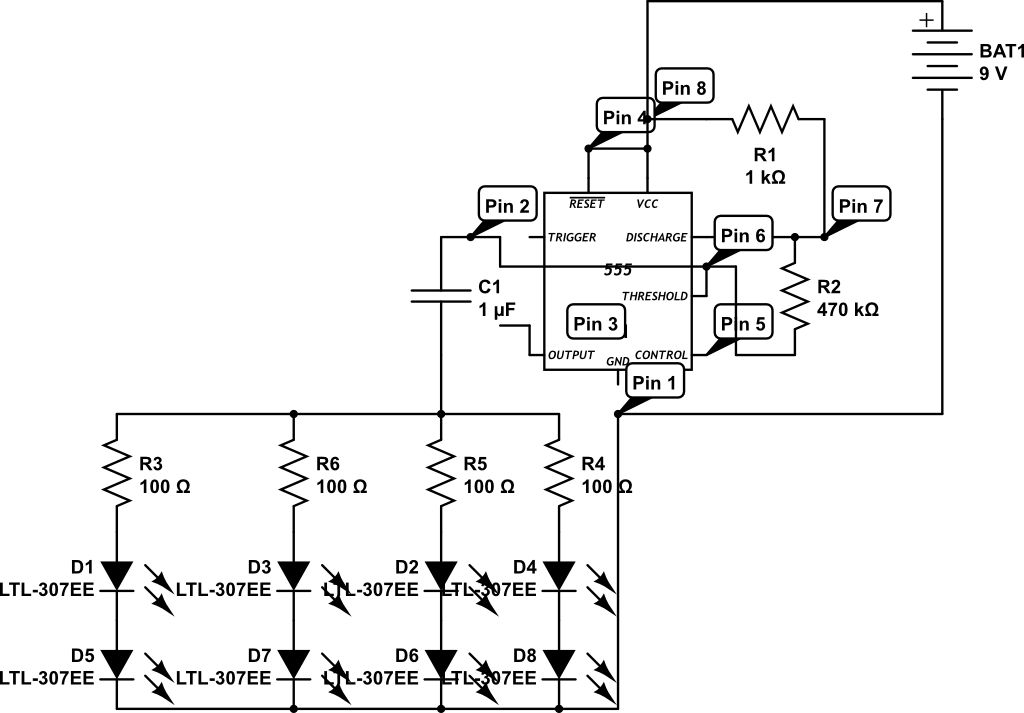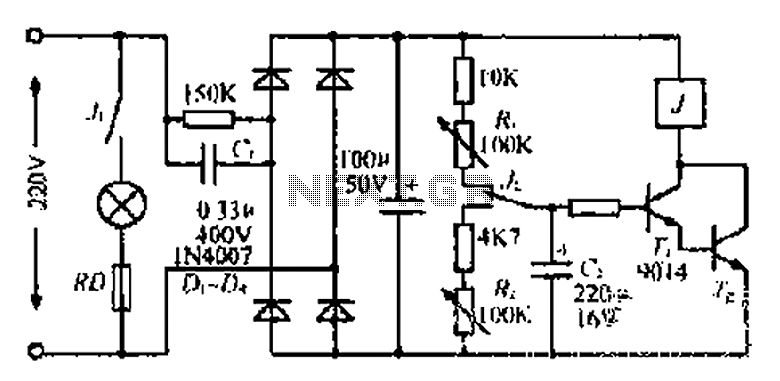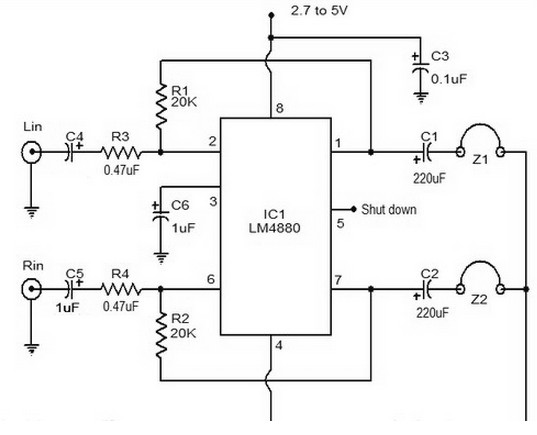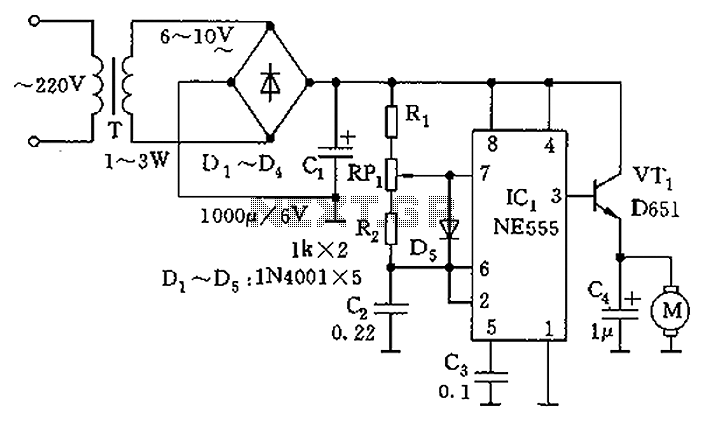
5V to 2.5V voltage regulator circuit
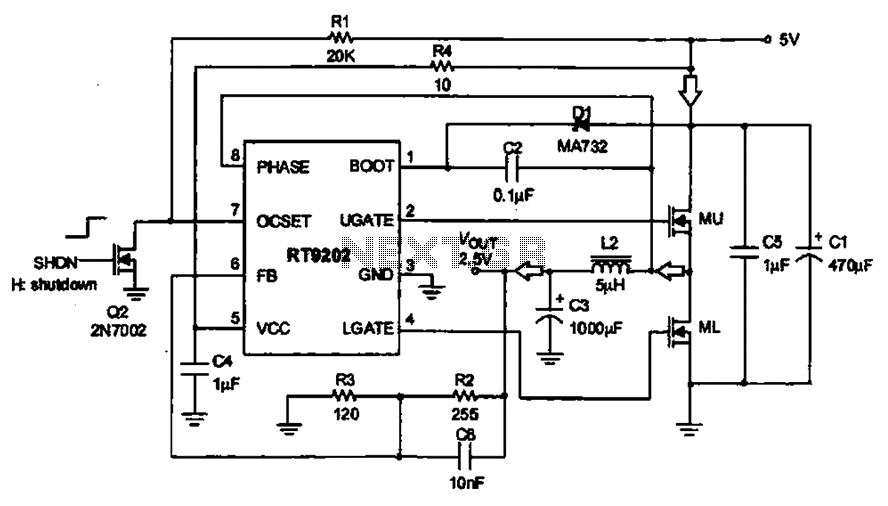
A 5V to 2.5V voltage regulator circuit is designed for use in computer motherboards. At its core, this circuit utilizes the RT9202 power management chip. The RT9202 functions as a switching pulse generating circuit, which, upon startup, converts a 5V power supply into a PWM output signal. This signal alternates between two effect transistors, MU and ML, effectively transforming the 5V DC input into a pulse signal. Following this, an LC filter processes the pulse signal, resulting in a regulated output voltage of 2.5V DC suitable for the motherboard circuitry.
The 5V to 2.5V voltage regulator circuit is an essential component in various electronic applications, particularly in computer systems where precise voltage regulation is required. The RT9202 chip is a highly efficient power management solution that operates by utilizing a switching mode to minimize power loss during voltage conversion.
The circuit begins with a 5V input, which is fed into the RT9202. Upon activation, the chip generates a pulse-width modulation (PWM) signal that controls the operation of two transistors, MU and ML. These transistors switch on and off in an alternating fashion, allowing the circuit to convert the steady 5V DC input into a variable pulse signal.
The alternating operation of the transistors is crucial as it helps in maintaining the desired output voltage while also improving efficiency by reducing heat generation. The generated pulse signal is then directed to an LC filter, which consists of an inductor (L) and a capacitor (C). The inductor smooths out the rapid changes in current, while the capacitor filters the voltage, resulting in a stable 2.5V DC output.
This output voltage is essential for powering sensitive components on the motherboard, ensuring that they operate within their specified voltage range. The design of the circuit emphasizes efficiency and reliability, making it suitable for modern computing environments where power management is critical. The RT9202 chip's integration into this circuit exemplifies the use of advanced technology in enhancing the performance and longevity of electronic devices.5V to 2.5V voltage regulator circuit It shows 5v to 2.5V regulator circuit computer motherboard. Seen from the ring, this circuit is a power management chip RT9202 as the core power supply circuit, RT9202 is a switching pulse generating circuit, 5v power supply circuit after start-up, and feet feet respectively opposite phase PWM output signal to two effect transistor MU, ML alternate work, the 5v DC into a pulse signal, after the LC filter becomes part of the circuit after the power supply voltage of 2.V DC-based board.
The 5V to 2.5V voltage regulator circuit is an essential component in various electronic applications, particularly in computer systems where precise voltage regulation is required. The RT9202 chip is a highly efficient power management solution that operates by utilizing a switching mode to minimize power loss during voltage conversion.
The circuit begins with a 5V input, which is fed into the RT9202. Upon activation, the chip generates a pulse-width modulation (PWM) signal that controls the operation of two transistors, MU and ML. These transistors switch on and off in an alternating fashion, allowing the circuit to convert the steady 5V DC input into a variable pulse signal.
The alternating operation of the transistors is crucial as it helps in maintaining the desired output voltage while also improving efficiency by reducing heat generation. The generated pulse signal is then directed to an LC filter, which consists of an inductor (L) and a capacitor (C). The inductor smooths out the rapid changes in current, while the capacitor filters the voltage, resulting in a stable 2.5V DC output.
This output voltage is essential for powering sensitive components on the motherboard, ensuring that they operate within their specified voltage range. The design of the circuit emphasizes efficiency and reliability, making it suitable for modern computing environments where power management is critical. The RT9202 chip's integration into this circuit exemplifies the use of advanced technology in enhancing the performance and longevity of electronic devices.5V to 2.5V voltage regulator circuit It shows 5v to 2.5V regulator circuit computer motherboard. Seen from the ring, this circuit is a power management chip RT9202 as the core power supply circuit, RT9202 is a switching pulse generating circuit, 5v power supply circuit after start-up, and feet feet respectively opposite phase PWM output signal to two effect transistor MU, ML alternate work, the 5v DC into a pulse signal, after the LC filter becomes part of the circuit after the power supply voltage of 2.V DC-based board.
